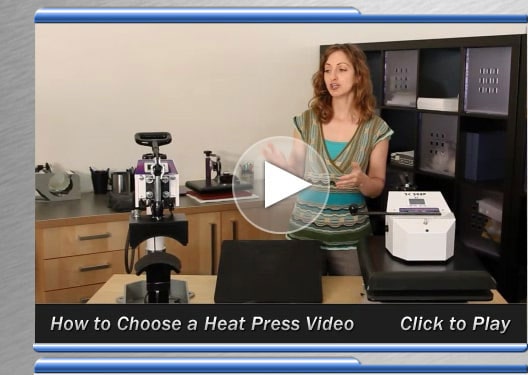

HEAT TRANSFER CENTRAL
What do heat presses do?
How do you apply an image onto a t-shirt? Or any garment? Or onto just about any product you want?
It has to be full color, it needs to last ...and it has to be real fast. You don't want to deal with messy inks, and can't afford to set up screens, and you only need ONE printed, or possibly bulk quantities, ...or somewhere in between. And it has to be profitable.
The answer is simple and has become the standard for quick, high definition, high quality, low cost imprinting of a vast range of materials.
The solution is Heat Transfer Press Technology
Geo Knight & Co is the premier manufacturer and supplier of heat transfer press machines used for these processes. We specialize in both commercial grade manual heat transfer presses as well as industrial large format automatic equipment.
We accommodate our customers with exactly the machinery they need to transfer press graphics and other embellishments onto a wide variety of materials. We manufacture according to the highest industry standards and only implement solid casting and steel structural frame designs, coupled with state of the art controls and heaters.
Our presses have been the backbone of literally thousands upon thousands of business over the past 4 decades, providing a reliable workhorse of a product that stands up to the demands of imprinting business, manufacturing and personal use.
What is the purpose of a heat press?
A heat press is the machine that presses a transfer onto an imprintable substrate. Using high temperatures and heavy pressures for a certain amount of time, the transfer is permanently embedded into the product.
Heat presses are recommended for professional and satisfying results simply because standard laminating devices and home hand irons can not get even near the temperatures required for a reliable transfer. Standard transfers require anywhere from 375° to 425° F demand serious force in pressing often from 40-80 psi. These temperatures and pressures are simply not possible with other heated devices.
What can I make with a heat press?
The following are some of the far more common items often heat pressed. The list by no means ends here.
- T-Shirts
- Caps
- Ceramic Plates
- Ceramic Tiles
- Mugs
- Mouse Pads
- Tote Bags
- Lettering
- Jigsaw Puzzles
- Wood / Metals
- Paper Memo Cubes
- Rhinestones/Crystals
- Other Misc. Fabrics & Materials
Contact us and let us know what your application is or what you want to press onto, and we can recommend the appropriate heat press and suggest a transfer solution.
What is the best heat press?
The answer to that question depends upon a variety of factors, including what products you plan to press, how much you plan to use your press, and even how much space you have to work with. To help you weigh the heat press options, please watch our "How To Choose A Heat Press" video.
What is a heat transfer?
A transfer is made up of a carrier paper and inks. When heated to a certain temperature and pressed with a significant amount of pressure for a certain amount of time, the transfer inks are passed over to the imprintable material. Some inks are adhered and embedded to the surface of the material, while others (namely, sublimation) permeate the coating of the material.
Transfers can be heat pressed onto fabrics (both natural and synthetic) using standard plastisol supplier transfers, color copier, or thermal wax & ink-jet computer transfer paper. Heat transfers can also be printed onto mugs, plates, tiles, mousepads, ceramics, metals, glass and wood. For these substrates, sublimation transfers are used. The important factor when heat pressing with sublimation transfers onto non-natural fabric substrates is to be sure the material has the proper polyester synthetic coating, as well as a UV coating if protection from the sun and other rays is an issue. For this reason it is best to get the materials pre-coated from a supplier.
How do I make heat transfers?
The three most common types of image transfers produced are Computer transfers, Color copier transfers, and what we refer to as "Supplier" transfers (either screen printed onto carrier paper or printed via off-set press with transfer inks). Computer transfers have become very popular over the past few years because of high quality printers, excellent transfer papers & inks and low cost hardware. The most common computer generated transfers are:
Ink Jet Transfers.
There are 2 major types of transfers produced with ink jet printers. The first is a wax based transfer paper used in tandem with plain ink-jet ink cartridges. The second is sublimation ink-jet cartridges used in tandem with plain ink-jet paper. With the first type, the ink-jet wax based "T-Shirt transfer paper" is passed through the ink-jet printer and then placed onto a fabric-based item and heat pressed. These papers will work with almost all ink jet printers but not with laser-jet. Ink-jet transfers are semi- translucent, so the fabric color will show through the design. This is why it is recommended to only use light colored garments or fabrics with these transfers (as well as thermal wax & color copier transfers mentioned below).
The second type of ink-jet transfers produced by sublimation ink-jet cartridges for making sublimation transfers are currently only available for certain Epson ink-jet printers. This is an extremely popular and dominant transfer method in the industry. Sublimation inks have proven to be one of the highest quality methods of making custom sublimation transfers with near off-set quality and strength. There is an excellent availability of a wide range of imprintable products for sublimation inks on the market today. Many of the company links below specialize in sublimation transfer inks & supplies.
Color copier transfers
Color copier transfers are produced using a special color copier transfer paper. After copying the image onto the paper, it is simply heat pressed to the material. This medium is successful for fabric based items. Standard color copier transfers will not act like sublimation transfers, or apply onto the same type of items sublimation works with. There is however a glazing, or post-curing / baking process that works with a specialty paper that helps color copy transfers stay applied to items such as mugs without being easily scraped off. There is also a special paper available for paper memo cubes which allows the cubes to be fanned (not stuck to one another) after heat pressing with a patented cube press.
Supplier Transfers
Supplier transfers are those that are pre-printed by a transfer supplier either by screening or offset press in designs shown by catalog or made by special order. The plastisol / hot-peel transfers from these companies are generally opaque, and therefore good for heat transferring onto dark items.
Miscellaneous
Other types of transfers include embroidered appliqués, die cut lettering, and flock transfers. Embroidered appliqués usually come as an embroidered patch with heat activated adhesive on the underside. Die cut lettering is a vinyl or other type of material that is precut in various numbers, letters, and custom shapes. The user lays the letters & numbers down on the garment and heat presses them. This is commonly how sports apparel is imprinted with names & numbers.
Summary
The three main ingredients in heat transfer printing images onto various materials are the Heat Press, the Transfer and the substrate to be printed. Heat press information can be found from the links at our home page. For information on ordering direct, or for a reference to one of our distributors, please feel free to email us or fill out our response form. If you prefer, call or fax us at the numbers provided on that page. The following is a sampler of a few of our distributors' web site links who may also provide other useful heat transfer supplies and equipment:
- IT Supplies
- JDS Industries
- Heat Press Nation
- Coastal Business
- DTG
- Lexjet
- Lawson Digital
- Imprints USA
- Pro World
- Stampinator
- Alpha Supply
- Reich Supply
- Valuerite Business (Canada)
- Transfer Paper Canada
- RA Smart (UK)
- GJS (Australia)
In closing, one challenge you will face is whether to produce the transfers in-house or to have them out-sourced by a supplier. If the target market is a one unit, custom item market, then the transfers should definitely be produced in-house for controlled turn-around time as well as cost. Dye-Sublimation / Thermal Wax printers will produce pretty much everything needed for an expansive custom imprinted product line. Many bubble-jet and ink-jet color printers accept T-shirt transfer paper (good for any fabric-based item) but can not produce dye-sublimation transfers unless utilizing the sublimation ink cartridges (well recommended) mentioned earlier. If the job in mind is for large, bulk quantities (300 and up) a transfer supplier should be considered for fast turn-around time and cost reasons. Transfer suppliers can produce high quality plastisol (hot peel or cold peel), sublimation and woven labels in short periods of time with a much smaller cost per transfer than dye sublimation printers, color copiers, or other small printers. Remember that non-porous items usually need to be coated with a synthetic polyester based coating in order to accept the sublimation dyes, unless the material is already synthetic such as certain plastics.
The only other consideration is whether your product can be printed with a typical flat heat press or requires a specially shaped platen or base. Some products are simply not conducive to heat transfer printing due to their exceptionally odd shape. Again, feel free to contact us with any questions or requests for special projects. We would be pleased to provide a solution.



Geo Knight & Co Inc. © 2025 • 52 Perkins St, Brockton MA 02302 • p (800) 525-6766 • p (508) 588-0186 • f (508) 587-5108 • info@heatpress.com
Phone: 800-525-6766 • 508-588-0186



